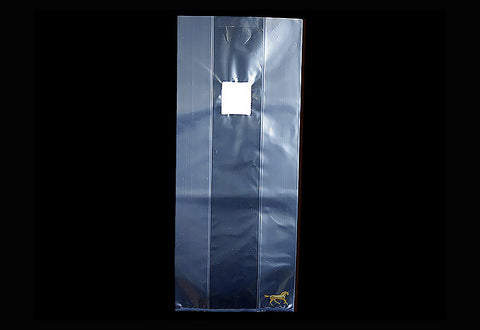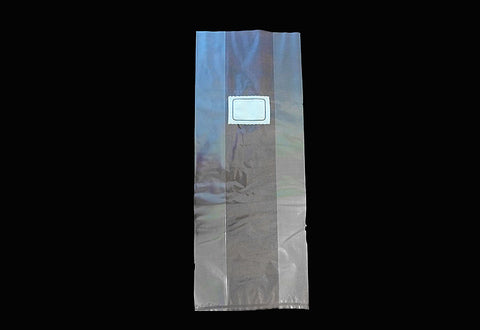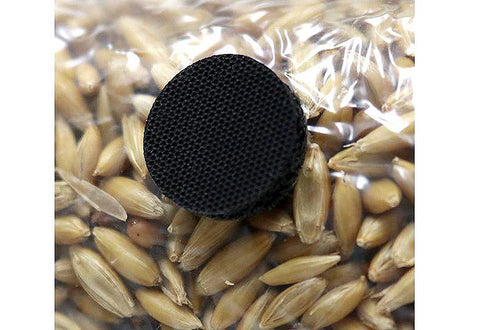Liquid Culture Jar 250 ml
• Chaque bocal est équipé d'un filtre, d'un port d'injection & prélèvement et d'une barre magnétique pour l'utilisation avec un agitateur magnétique.
• Nous produisons les bocaux sur demande. Les délais peuvent donc varier entre 2 et 6 semaines en fonction de la disponibilité des cultures et de notre planning.

Liquid mycelium cultures are generally used to inoculate sterilized mycelium on grains for the manufacture of "blanks" or "inoculums", which in turn are used to inoculate fruiting substrates such as straw or sawdust. They are composed of a nutrient liquid and mycelium.
You can also use them with our bags of already sterilized mycelium on grains or our agar culture media .
The mycelium is second generation: the first generation is selection on a petri dish, which is followed by multiplication in liquid culture. These liquid cultures will generally be used to produce mycelia on mycelium on grains , which in turn will be used to inoculate other mycelium on grains or a final fruiting substrate.
Our mycelia are produced in the laboratory to guarantee their quality and the absence of any contamination. Furthermore, all cultures are tested before being used.
Use
250 ml jars, equipped with a filter and an injection port.
Before using, shake the jar gently, swirling the liquid so as to break up the mycelium into small pieces and distribute it throughout the liquid.
We recommend that before each laboratory manipulation, you wash your hands with soap and water, as well as wear gloves. Work in the cleanest environment possible to limit the risk of contamination.
Clean the injection area with 70° alcohol, as well as the tip of the syringe. Unscrew the cap and screw in the needle.
Insert the needle into the jar, and tilt the jar so that the needle comes into contact with the liquid.
Take and inject into the substrate of your choice.
Note: We guarantee the purity of our strains and cultures. This type of cultivation is not intended for beginners. We do not guarantee the final success of the cultures, which depends above all on your ability to master the different stages of cultivation according to the rules of the art.
Conservation
Storage in the fridge (2-4°). Avoid freezing.
There is no expiration date. Although it can theoretically be stored for 1 year or more, we recommend using it within 3 to 6 months after receipt and storage in the refrigerator.
Gradually the mycelium will become denser, which will make the liquid more difficult to use. Furthermore, the mycelium can lose strength, and the risk of contamination increases over time.
List of Varieties
When ordering, we invite you to indicate the list of varieties chosen in comments, when confirming the basket. You can also send them to us by email
Oyster mushroom KB1 : Large and thick variety. The feet are thick but tender up to the base. Very good productivity. Good conservation, good taste quality.
Elm oyster mushroom : White oyster mushrooms, rather rustic varieties. Wide and thin hats. Rapid growth. Good productivity. Average conservation.
Florida oyster mushroom : Heat-resistant variety. Productive even in cool temperatures (min 10°). Cluster made up of a set of small caps of 3-5 cm. Color tending towards bluish-gray in cold conditions, towards off-white in warm conditions. Robust mycelium
Prince oyster mushroom : Cascades of small silver-gray caps tending towards gray-brown below 15°. Classic commercial variety. Short, slender feet. Good productivity and good conservation.
Blue Brat Oyster Mushroom : Originally from Bratislava. Small silver gray hats. Average productivity but hardy and resistant variety with rapid growth.
King of Pearl oyster mushroom : Beige-gray color caps, average productivity, aggressive and fast mycelium.
Pearl oyster mushroom : small beige hats. Basic hardy variety. Average productivity but adapts well to all temperatures.
Pathfinder oyster mushroom : large beige fruits. Relatively fragile, but good productivity. Large tender feet. Very fine fragrant almond taste.
Soignes oyster mushroom : winter variety from the Soignes Forest (South of Brussels). Mar gray color tending towards brown. Very aggressive mycelium. Enjoys the cold and the outside air.
Pulmonary Oyster Mushroom : Also called the Italian oyster mushroom, it tolerates heat well, but it can also be grown all year round. Very fast growth, easy to anticipate harvests. Light gray color when grown in heat to dark brown below 15°. Grows in small individual bouquets rather than clusters. Harvest young. Adapts well to different substrates, very resistant.
Yellow Oyster Mushroom : flavor and texture quite different from other oyster mushrooms. Slightly aniseed taste. Prefers temperatures >18°. The yellow color becomes more pronounced with the amount of light. Relatively fragile caps, harvest young.
Pink oyster mushroom : likes heat 25-30°. Colonization and rapid growth. Harvest young. Shelf life limited to a few days. Very nice visual rendering.
Black Pearl : Cross between a variety of oyster mushrooms and eryngii.
Eryngii "Kings" (pleurotus eryngii): commercial variety
Lion's Manes "PomPom" (hericium erinaceus): commercial variety
Comb Thoot (Hericium coraloides)
Champignons de Paris Blancs (Agaricus bisporus)
Shiitake 3790 (lentinula edodes): commercial variety
Shiitake 3782 (lentinula edodes): variety more suited to pasteurized substrates, with a straw base
Reishi Red (ganoderma lucidum)
Reishi Noir (ganoderma sinense)
Reishi Lingzhi (ganoderma multipleum)
Strophaire (Stropharia rugosoannulata)
White Shimeji (hypsizigus tessulatus): commercial variety
Smoky blade hypholoma (capnoid hypholoma)
Nameko (pholiota namekos): commercial variety
Chestnut s (pholiota adiposa): commercial variety
Pioppino (agrocybe aegarita)
Elm Oyster (hypsizigus ulmarius): the true elm oyster mushroom, a little more complex to produce than the pleurotus ostreatus
Bluefoot (lepista nuda)
Enoki Doré (flamulina velupites)
Oreille de Juda (ears of Juda)
Coprinus comatus (coprinus comatus)
Maïtake (Grifola Frondosa): commercial variety
Cultivated Volvara (volvaria volvacea)
Tiger lentils (lentinus tigrinus)
Stiptic Panel (panellus stipticus): bioluminescent mushroom
Sulfur Polypore (Laetiporus sulphureus): variety from a mushroom collected by us in a wood in Louvain-la-Neuve (Belgium), growing on a cherry tree trunk. To be cultivated preferably on semi-buried logs
Black Morel (morchella elata): saprophytic variety of French origin
Cordyceps Militaris (cordyceps militaris): Excellent variety of Kaizen Cordyceps in England






